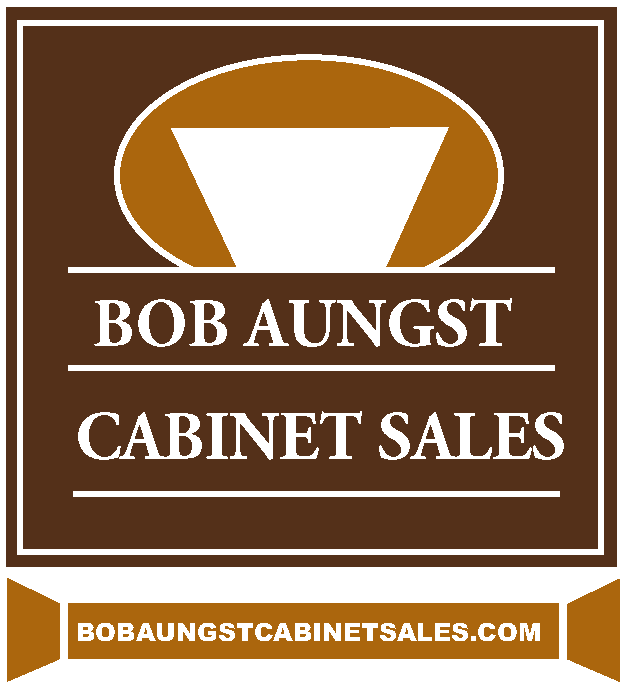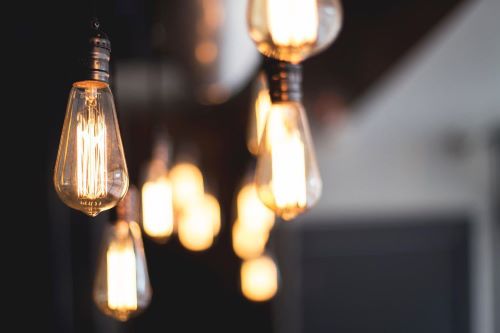Great Kitchen Design Needs LED Lighting
LED lights in the kitchen have replaced incandescents, fluorescents and halogens as the ideal lighting choice for many reasons that we will look at in this article
Thanks to advancements in LED lighting technology, it is easier than ever to efficiently light a kitchen. Everything in a kitchen, no matter how big or small the space, can benefit from LED illumination.
The importance of lighting in a kitchen is two-fold. One is, of course, functionality – having sufficient light on surfaces to see what you’re doing. The other is decorative lighting which can enhance a kitchen in the same way jewelry enhances an outfit.
Since today’s kitchens work as gathering and entertaining spaces, in addition to the traditional uses of cooking and eating, using lighting to set the mood has become important when designing the kitchen.
It’s been said that no matter how good a kitchen design may be, without great lighting, it’s all for nothing. As a result, lighting should be considered as carefully as choices for appliances, cabinet finish, flooring material and color scheme.
The importance of lighting in a kitchen is two-fold. One is, of course, functionality – having sufficient light on surfaces to see what you’re doing. The other is decorative lighting which can enhance a kitchen in the same way jewelry enhances an outfit.
Since today’s kitchens work as gathering and entertaining spaces, in addition to the traditional uses of cooking and eating, using lighting to set the mood has become important when designing the kitchen.

It’s been said that no matter how good a kitchen design may be, without great lighting, it’s all for nothing. As a result, lighting should be considered as carefully as choices for appliances, cabinet finish, flooring material and color schem
Why Use LED Lighting
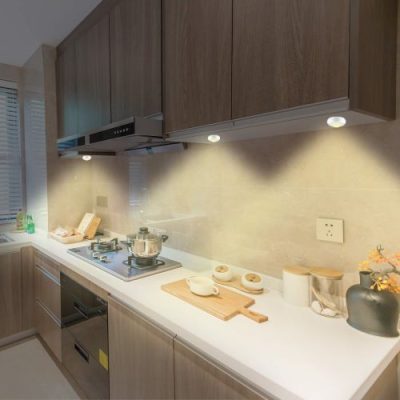
Brightness. Traditional lighting is not as bright as LED light. In the kitchen where your clients are working with knives and hot burners, it is much safer to have plenty of light to ensure their safety. Further, under cabinet LEDs not only provide needed light, but also reduce shadows on countertops.
Energy Efficiency. LED lights are highly energy efficient. In addition, LEDs with the ENERGY STAR designation use at least 75 percent less energy than incandescent lights.
Longer Lasting. LEDs will work for years. 1,000 hours is the usual lifespan of incandescent bulbs. That’s barely a year with several hours of use each day. 5,000 hours or more is LED light’s rating. In other words, at the same rate of use, they will last for decades.
Versatility. Designers are installing LEDs in more places throughout their kitchen designs, and not just in overhead lights. LEDs can be found under cabinets, inside drawers, under the toekick, inside cabinets, under glass countertops and more unexpected places.
Cool light. LED lights are cool, and not just in a “hip-and-happening” way. They convert the electrical energy they use into visible light rather than heat. Traditional bulbs generate a lot of heat as well as light. LED lights stay cool even during prolonged use. They don’t need time to warm up when first turned on, and they do not get hot during operation.
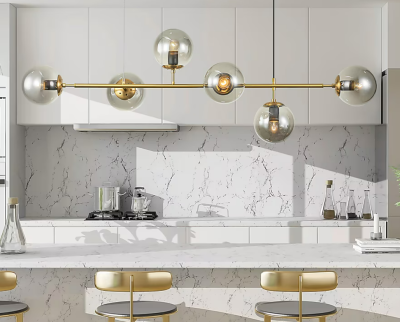
Flexibility. LED lights come with a low profile and thin wires, making it possible to easily light up places where space is limited, and a traditional lightbulb won’t fit. For example, inside cabinet drawers and interiors. LED tape lights are even more flexible. They can be installed anywhere, such as under floating shelves or inside an appliance garage to light the interior.
LED Lighting and Kitchen Design
Lighting selections are increasingly becoming an important part of the kitchen’s style. And advancements in LED lighting have brought about lots of changes to kitchen designs.
For example, in the kitchen of a home with a modern style kitchen, the lighting layout and fixture selections can illuminate and highlight the materials that create the contemporary vibe. Pendant lights over the island further enhance the design. Recessed can lights in the ceiling combined with undercabinet lighting and toe kick lighting, give the kitchen full LED lighting coverage.
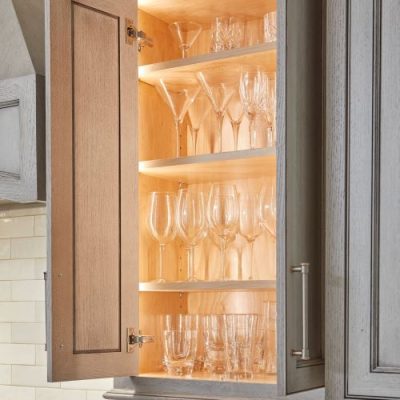
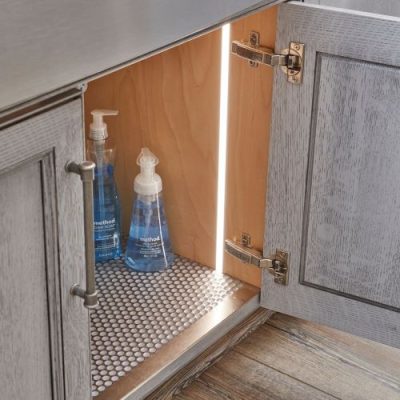
LED Lighting Sources
Today’s LED light sources are available in smaller sizes and outputs, giving designers a broad selection of products to fit lighting into their kitchen designs.
Recessed LED can lights don’t take up much space in the ceiling, so designers can install both cans and pendants. Can lights meet the functional needs of the space, while pendants provide directional lighting and attractive decorative elements.
When using recessed fixtures, design pros recommend choosing smaller-aperture ceiling lights with an opening of 2-3” and trimless designs that are installed flush to the ceiling. Recessed track systems also work well. They hold multiple lights within a single cut in the ceiling.
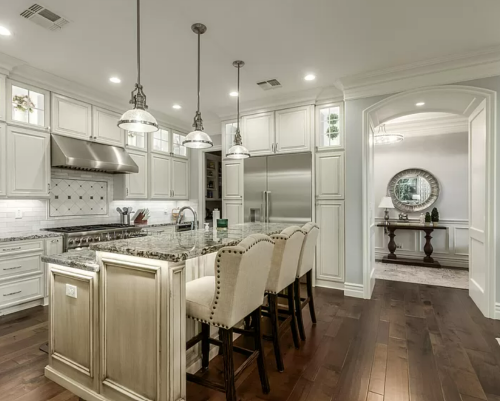
Here’s a reminder of the rule of thumb for pendant placement over an island:
- Minimum 24″ apart
- Approximately 12″ to 24″ from the counter edge
- Roughly 30″ to 40″ from the top of the counter to the bottom of the lighting fixture
Layers of Light
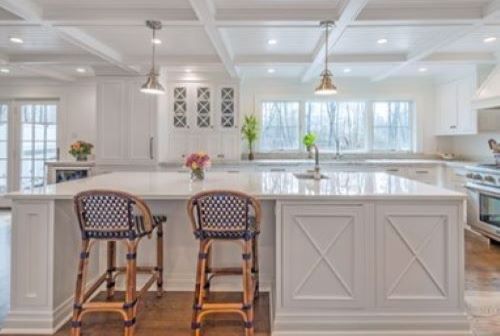
Designers today know not to rely on only one light source. Instead, they recommend layering the light. LED lights are available in an amazing variety of fixture types, thus making it easier to layer light, which is an important design consideration.
Work surfaces need to be well lit so homeowners can perform various kitchen duties without glare. In addition, they want the general overall lighting in their kitchen to be controllable and dimmable to set the mood while still having abundant lighting to efficiently prep, cook and clean up.
Lighting isn’t only about artificial solutions. Natural light should be emphasized when planning the kitchen lighting scheme. Sunlight is wonderful because it changes the mood of the space and warms it up.
Control the Mood
To take full advantage of all the layers of lighting, you’ll need a way to control them. The different types of lighting – ambient, task and accent – should be split up on separate switches with dimmers.
By installing a home-automation system with smart dimmers, you can set scenes for various times of day and different uses. Set an evening scene where the lights are dimmer and a morning scene where the lights bright.
LEDs Replace Fluorescents and Halogens
Fluorescent lighting has always been a problem for kitchen designers. Fluorescent fixtures were annoying when they would buzz and flicker. Plus, they were mostly ugly. Further, for many years, fluorescents didn’t have warm color temperatures, making it very difficult to create a comfortable living space. By using LED lighting, designers have been able to achieve much better lighting in their kitchens.
In the past, another option to fluorescents was halogens. Although they produced more focused light, they also produced a lot of heat. Plus, they were not energy efficient. Now, LED lights have pretty much replaced both fluorescent and halogen lights.
Conclusion
LED lights are energy-efficient, long-lasting and emit less heat than halogens. They use up to 90% less energy than incandescent bulbs, last up to 40 times longer and offer high-quality light output. LED lights are also versatile and suitable for any space, making them an excellent element to include in kitchen designs.
Bob Aungst Cabinet Sales is a full-service rep agency with the goal of matching kitchen designers and remodelers with the cabinet manufacturers best suited to their business’ style and clientele. Owner Bob Aungst III represents Brighton Cabinetry, US Cabinet Depot, Integrity Cabinets and StyleCraft Luxury Custom Cabinets.
